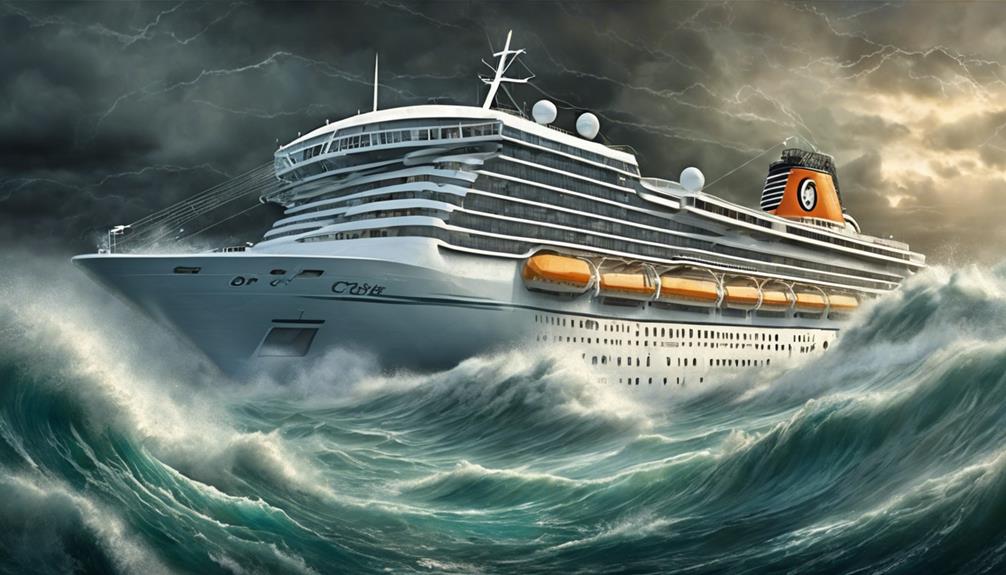In relation to steering a cruise ship through a hurricane, there’s a universal agreement that ‘prevention is better than cure.’
But what happens if the unexpected occurs? Cruise lines have a plethora of safety measures in place to ensure the well-being of passengers and crew. From route adjustments to real-time updates, the strategies employed during such events are vital.
Let's explore the protocols that dictate the actions taken to safeguard everyone on board should a hurricane loom on the horizon.
Key Takeaways
- Dedicated meteorologists monitor real-time weather to ensure passenger safety.
- Crew follows strict safety protocols, including evacuation procedures and securing the ship.
- Emergency response procedures and drills prepare crew for swift reactions during hurricanes.
- Sheltering in place strategies and designated safe areas maintain stability for passengers.
Cruise Lines' Hurricane Preparedness
During a cruise, cruise lines ensure their hurricane preparedness by deploying dedicated meteorologists equipped with advanced technology for real-time weather monitoring and informed decision-making. These meteorologists play a critical role in tracking storms using computers, satellites, radars, and GMDSS to make accurate predictions and guide the ship safely.
Communication channels are vital during these times, and captains relay weather updates to passengers through public address systems, written correspondence, TV broadcasts, and social media platforms. Chief meteorologists go the extra mile by recording forecast videos for staterooms, ensuring guests stay informed.
Social media also serves as a quick and efficient means of providing updates and maintaining guest connection throughout the voyage. Passengers are encouraged to follow the meteorologist on Twitter for the latest weather news, allowing for direct access to real-time updates and fostering a sense of security and preparedness among guests.
Safety Protocols for Passengers
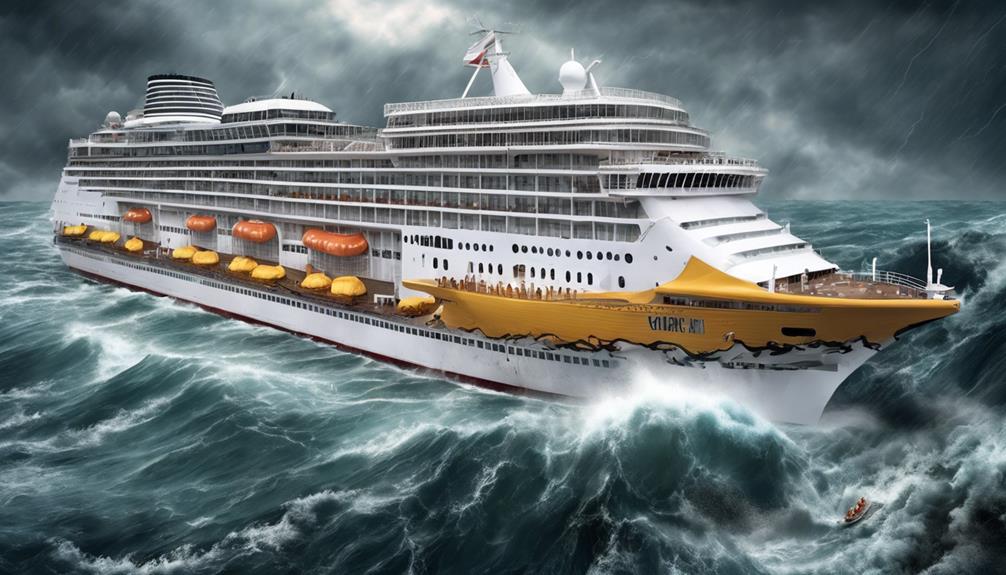
We'll now address crucial aspects of passenger safety during hurricanes on a cruise: evacuation procedures and emergency drill requirements.
It's imperative that passengers familiarize themselves with evacuation routes and assembly points in case of an emergency.
Following these protocols diligently ensures the safety and well-being of everyone on board.
Evacuation Procedures
Passengers on a cruise ship are provided with detailed evacuation procedures to ensure their safety in the event of a hurricane. During emergencies, passengers must remain calm and comply with crew instructions. Evacuation drills, conducted at the start of the cruise, familiarize passengers with emergency protocols.
Lifeboats and life rafts are available for safe evacuation if necessary. Crew members undergo rigorous training to effectively guide and assist passengers during evacuations. This ensures the orderly and safe evacuation of all individuals onboard.
In the event of a hurricane, these evacuation plans are crucial for passenger safety. Cooperation with crew assistance is essential for a successful evacuation and the well-being of everyone on the cruise ship.
Emergency Drill Requirements
To ensure passenger safety and compliance with maritime regulations, all individuals aboard a cruise ship are required to participate in emergency drills at the commencement of the voyage. During these drills, passengers must engage in various activities:
- Lifeboat drills: Passengers learn how to board lifeboats safely.
- Muster station assignments: Each passenger is designated a specific muster station for assembly.
- Emergency signal recognition: Participants are educated on identifying and understanding emergency signals.
- Life jackets and evacuation routes: Crew members demonstrate the proper use of life jackets and provide instructions on evacuation routes.
These drills are vital for ensuring that passengers are well-prepared in case of an emergency, enabling a swift and organized response to potential threats.
Crew Responsibilities During Hurricanes
As crew members, we execute safety protocols and emergency response procedures meticulously during hurricanes. Our responsibilities involve securing the ship, aiding passengers, and maintaining constant communication with the captain.
Furthermore, we stay informed about weather updates and collaborate closely with the captain to ensure the safety and well-being of all passengers onboard.
Crew Safety Protocols
During hurricanes at sea, crew members diligently execute safety protocols, ensuring the ship's security and passengers' well-being through coordinated actions and adherence to established procedures.
- Crew members secure the ship by fastening all loose items, closing windows and doors, and checking emergency equipment.
- They assist passengers by providing guidance, ensuring they're in safe areas, and addressing any concerns promptly.
- Monitoring weather updates is crucial for crew members to anticipate changes, adjust plans, and keep everyone informed.
- Following the captain's instructions is vital, as the crew must act promptly and effectively to implement emergency plans and minimize risks during inclement weather.
Emergency Response Procedures
When faced with hurricanes while at sea, crew members follow specific emergency response procedures to ensure the safety of passengers and the ship. Crew members are extensively trained for this scenario, with responsibilities that include securing the ship, monitoring weather updates, and ensuring passenger safety. Effective communication with passengers, providing timely updates, and enforcing safety protocols are also crucial. Rigorous emergency drills and training sessions prepare crew members to swiftly respond to hurricane situations. Coordination among the crew is vital for implementing evacuation plans, managing onboard resources, and maintaining calm among passengers. Adherence to these procedures ensures a proactive approach to safeguarding both passengers and the vessel during turbulent weather conditions.
Ensuring the safety of passengers and the ship during hurricanes requires crew members to be well-prepared and coordinated in their response efforts. From securing the ship to communicating effectively with passengers, crew members play a critical role in maintaining safety. Rigorous training and drills equip them to handle emergencies swiftly and efficiently. Coordination among the crew is essential for implementing evacuation plans, managing resources onboard, and keeping passengers calm. By following these procedures, crew members take a proactive approach to safeguarding all individuals on board during challenging weather conditions.
Emergency Communication Procedures
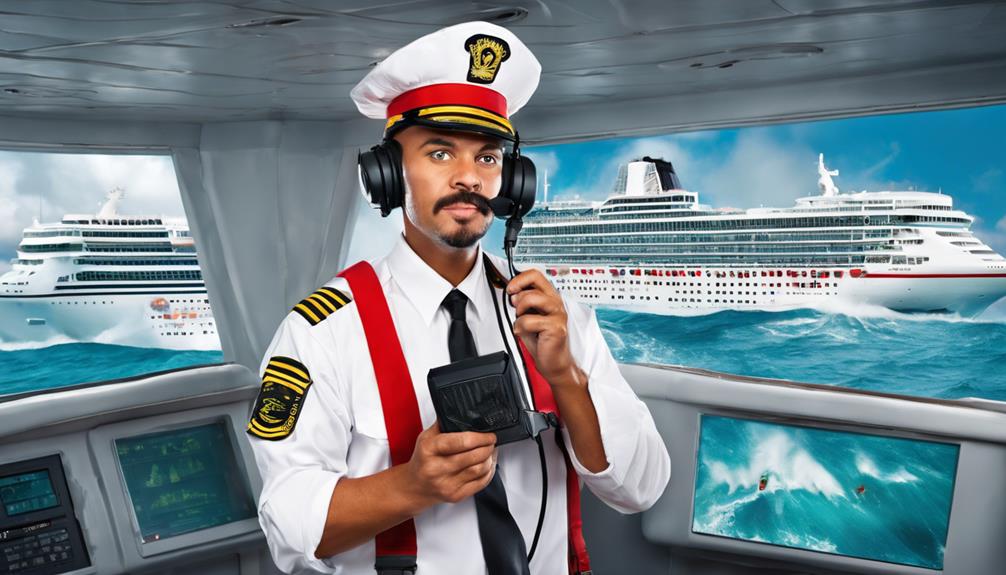
Emergency updates regarding hurricane safety measures on a cruise are relayed to passengers through various communication channels onboard, ensuring timely and clear dissemination of critical information.
- Captains communicate emergency updates using public address systems, written correspondence, TV screens, and social media platforms.
- Passengers receive pre-sailing email notifications for real-time updates on weather conditions and emergency procedures.
- Cruise lines have specific protocols for informing passengers about hurricane policies and changes in itinerary due to safety concerns.
- Emergency communication channels are established onboard to keep guests informed about safety measures and any potential impacts of the hurricane.
These measures ensure that passengers are well-informed and prepared for any safety concerns that may arise during the cruise. By utilizing multiple communication platforms and providing real-time updates, cruise lines prioritize the safety and well-being of their guests in the event of a hurricane.
Evacuation Plans and Drills
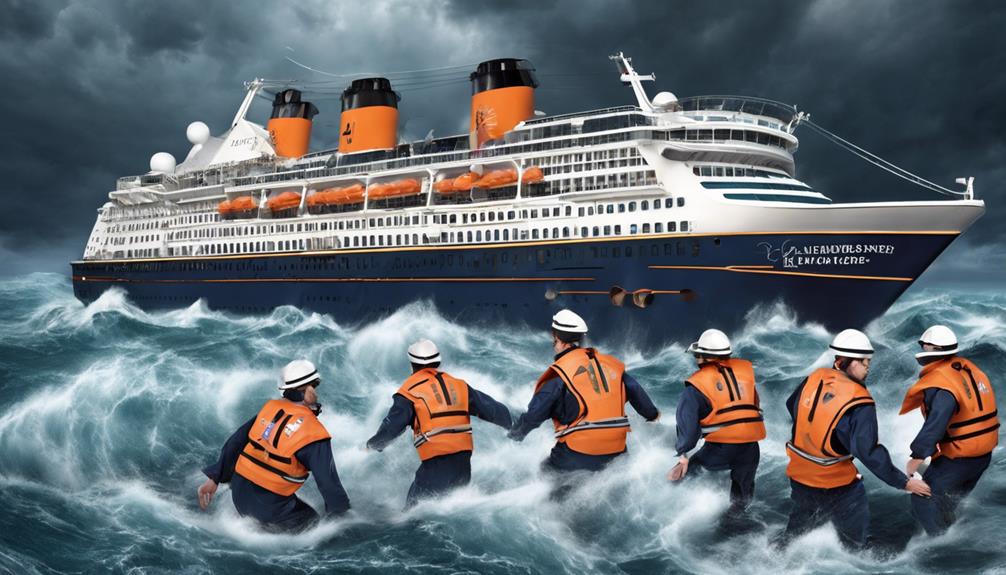
Utilizing designated assembly stations and lifeboats, cruise ships conduct mandatory evacuation drills to prepare passengers for orderly responses in emergency situations. These drills are integral to ensuring passenger safety and emergency preparedness. Crew members undergo rigorous training to assist passengers during evacuations and guarantee adherence to safety procedures. Communication systems play a vital role in relaying evacuation instructions effectively, utilizing multiple languages to reach all individuals on board.
During evacuation drills, passengers are directed to their assigned assembly stations where crew members provide instructions on donning life jackets and boarding lifeboats. The orderly process practiced during these drills ensures a swift and organized response in the event of a hurricane or other emergencies. By familiarizing passengers with evacuation procedures beforehand, cruise ships aim to mitigate panic and confusion, promoting a safe evacuation for all individuals on board.
These evacuation plans and drills are fundamental components of cruise ship safety protocols, emphasizing the importance of preparedness and cooperation in ensuring a secure environment for all passengers.
Sheltering in Place Strategies
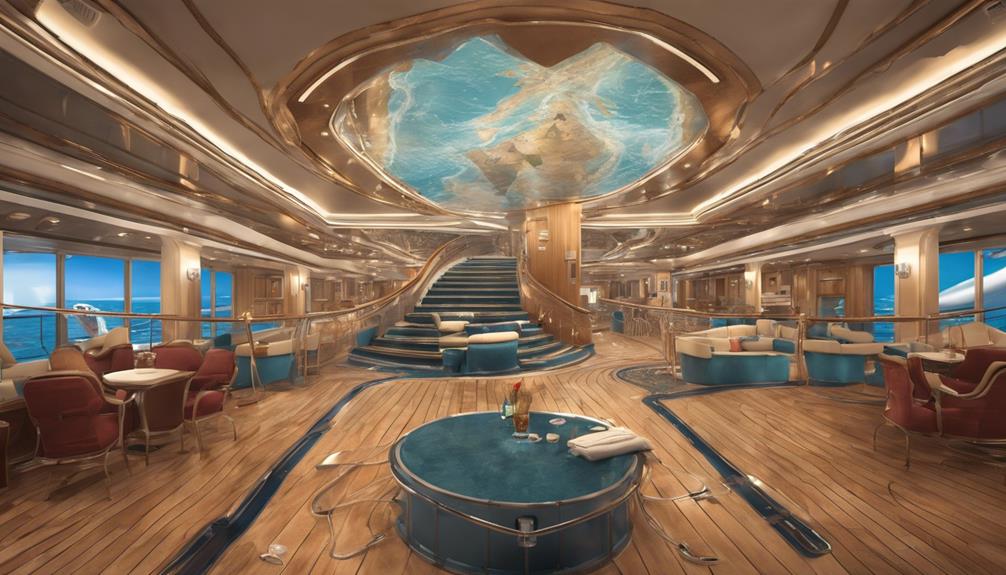
To ensure passenger safety during hurricanes, cruise ships provide designated safe areas where passengers are instructed to shelter in place, emphasizing the importance of remaining in cabins or assigned locations for protection.
When sheltering in place during rough weather conditions, the following strategies are implemented:
- Secure Loose Objects: Crew members secure all loose objects to prevent potential hazards during the storm.
- Close Watertight Doors: Watertight doors are closed to enhance the ship's structural integrity and prevent water ingress.
- Utilize Communication Systems: Communication systems are used to relay important information to passengers regarding the storm's progress and safety protocols.
- Leverage Stability Features: Cruise ships are equipped with stability features to minimize movement and ensure a stable environment for passengers.
Importance of Travel Insurance
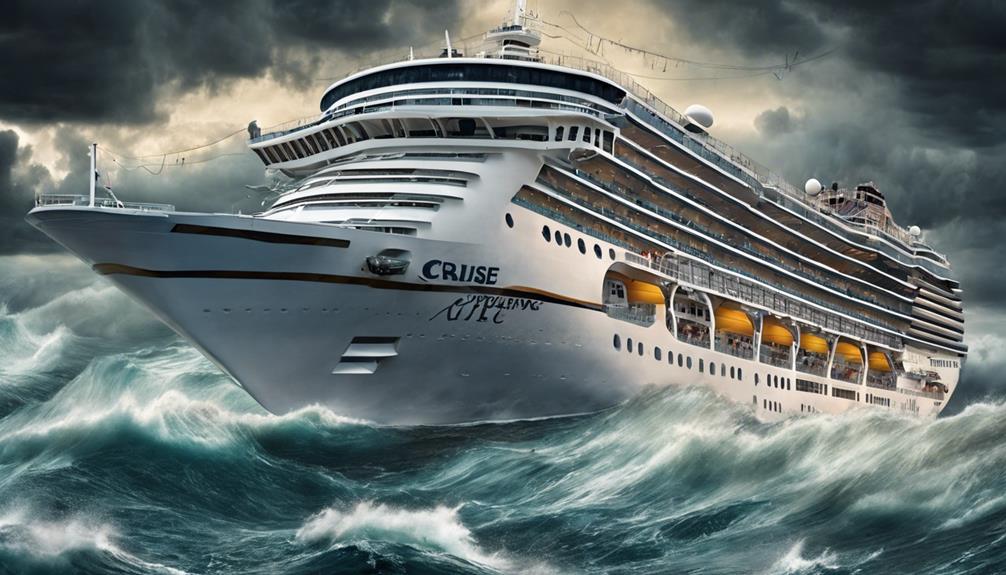
Securing travel insurance before embarking on a cruise is essential for mitigating unforeseen costs and protecting against potential financial losses. Travel insurance provides coverage for expenses and losses that may not be reimbursed by the cruise line. In the event of a hurricane or other unexpected events during the cruise, having travel insurance can offer peace of mind and financial protection.
Policies typically include reimbursement for missed excursions, flight delays, and other disruptions caused by unforeseen circumstances like hurricanes. Faye stands out as a recommended insurance carrier for cruise travel, offering comprehensive coverage to absorb costs during peak travel times and safeguard pre-cruise travel components. By investing in travel insurance, passengers can navigate unexpected events with greater ease and confidence, knowing that they've a safety net in place.
Passenger Compensation Policies
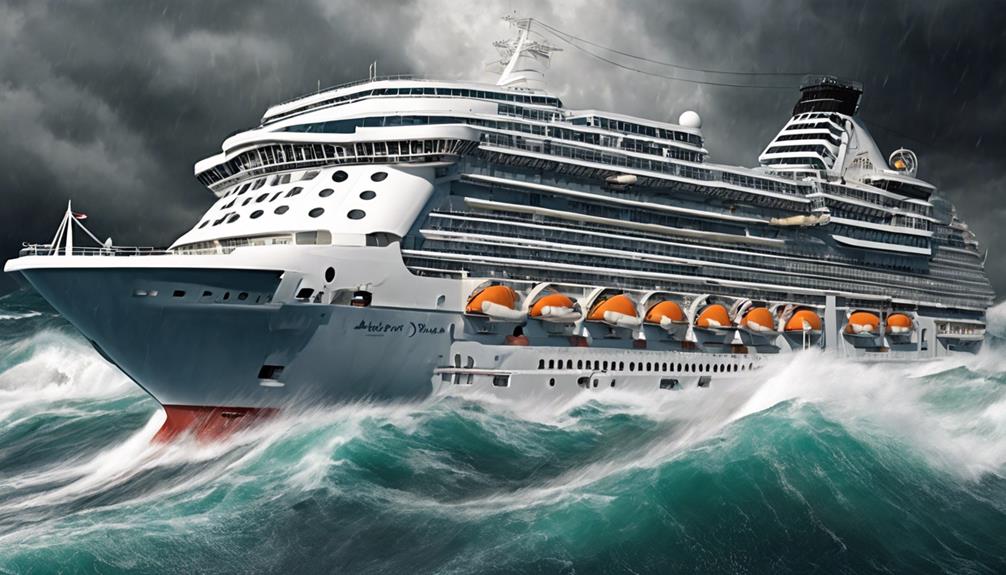
Passengers on cruises are provided with specific compensation policies by cruise lines in the event of hurricanes, which may include future cruise credits or pro-rata refunds. When cruising during hurricane season, being aware of these policies is crucial. Here are key points to understand Royal Caribbean International's compensation policies:
- Extensions and Itinerary Changes: In case your itinerary is affected by a hurricane, Royal Caribbean may offer extensions or changes with complimentary onboard extras.
- Booking Modifications: Passengers can directly contact Royal Caribbean or their travel agents for booking alterations or cancellations if needed.
- Pre-Sail Refunds: Full or partial refunds may be possible before the sailing date due to weather concerns.
- Reimbursement Options: Compensation for missing ports or itinerary changes can come in the form of onboard credits, vouchers, or refunds.
Understanding these policies can provide peace of mind when planning a cruise during hurricane season. Remember to review travel insurance policies for additional coverage in such situations.
Post-Hurricane Recovery and Resumption
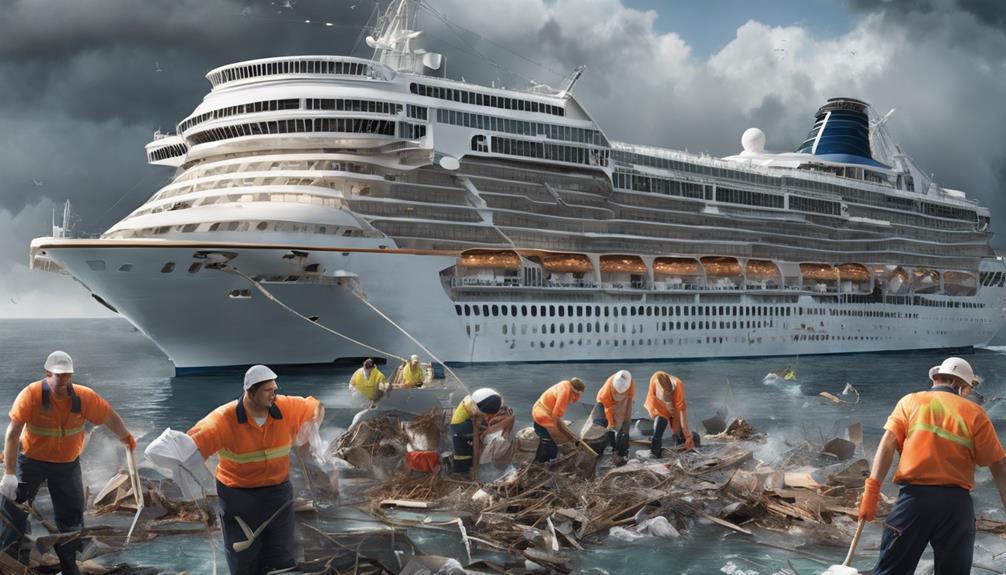
Upon assessing port conditions and ensuring passenger safety, cruise lines promptly initiate post-hurricane recovery and resumption protocols to restore normal ship operations.
Crew members diligently work to address any damage caused by the hurricane, focusing on repairs to critical systems to ensure the safety and comfort of passengers.
Itinerary adjustments are made as needed to steer clear of areas still affected by the hurricane, prioritizing passenger safety above all else. Passengers are kept informed of any changes to the schedule and are provided with any necessary assistance during the recovery process.
Cruise lines place a high emphasis on passenger well-being, ensuring that all measures are taken to swiftly return the ship to its normal operations.
Throughout this period, crew members remain dedicated to their roles, working tirelessly to bring the ship back to full functionality and providing the necessary support to passengers as they navigate through the post-hurricane recovery phase.
Frequently Asked Questions
What Do Cruises Do if There Is a Hurricane?
If there's a hurricane during a cruise, we change routes and update passengers through various channels. Options like continuing, canceling, or modifying plans are given. Cruise lines have policies for compensation, ensuring safety and flexibility.
Is It Safe to Take a Cruise During Hurricane Season?
During hurricane season, we prioritize passenger safety on cruises by monitoring weather conditions closely. Our advanced technology allows us to navigate away from storms swiftly. Rest assured, we are equipped to provide a smooth sailing experience.
What Happens if There's a Storm While You're on a Cruise?
If there's a storm while on a cruise, the captain and crew will keep us informed and adjust the route to ensure safety. We'll follow safety protocols and instructions. Our well-being is the top priority.
What if There Is an Emergency on a Cruise?
In case of an emergency on a cruise, trained crew members are available 24/7 to respond promptly. Passengers are briefed on safety procedures during the mandatory drill. Medical facilities onboard can handle basic needs.
Conclusion
In conclusion, cruise lines have extensive safety measures in place to ensure passenger well-being during hurricanes. From changing routes to providing real-time updates, crew members are trained to handle emergencies efficiently. Passengers are kept informed of policy changes and given options for their safety. With thorough planning and communication, cruise lines prioritize passenger safety above all else.
But, have you ever wondered how you'd fare on a cruise during a hurricane?
Claire, a creative soul with an unquenchable thirst for storytelling, is an integral part of the Voyager Info team. As a dedicated writer, she weaves captivating narratives that transport readers to enchanting cruise destinations and beyond.
Claire’s love affair with writing began at an early age when she discovered the magic of words and their ability to craft worlds and emotions. Her innate curiosity led her to explore various literary genres, but it was travel writing that truly captured her heart. Drawing inspiration from her own globetrotting adventures and encounters with diverse cultures, Claire embarked on a journey to become a travel writer par excellence.

